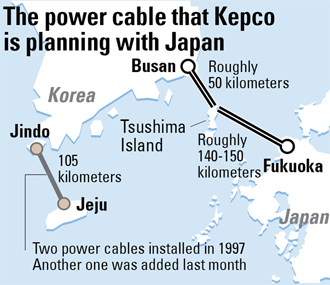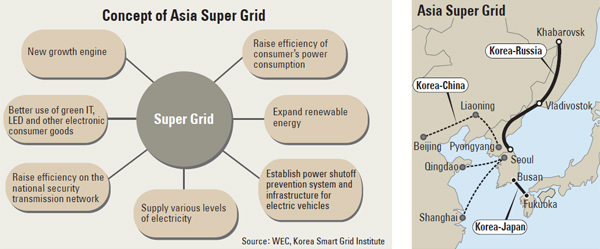Kepco wants grid linked to Japan

The project will create a new grid to share power from Korea, which has a surplus, with Japan, which has a shortage of power due to the turning off of its nuclear power plants after the earthquake, tsunami and Fukushima nuclear power plant disaster in March 2011.
The distance from Busan to Tsushima is 50 kilometers and the distance from Tsushima to Kyushu is between 140 and 150 kilometers.
“Softbank Chairman Masayoshi Son has shown interest in participating in the submarine power cable project,” said a high ranking official at Kepco. “Recently Kepco management and Chairman Son held a meeting where we reached an agreement on this issue.”
He said Kepco already has experience in setting up submarine cables. It installed two cables that stretch 105 kilometers between Jindo, South Jeolla, and Jeju Island. One was laid in 1997 and the second just last month.
The reason the Softbank chairman is showing interest in the cable connecting Korea and Japan is because he proposed the establishment of an Asia Super Grid after the 2011 tsunami that damaged the nuclear power plant in Fukushima. The idea was addressed during the Global Green Growth Summit in May 2012.
It has been Son’s long term vision to connect Korea, China, Japan, Russia and Mongolia’s power gird for a steady supply of energy.
The plan is for Russia, China and Mongolia, which are filled with natural resources including fossil fuel as well as solar and wind, to produce the energy and Korea and Japan to import it.
“The submarine cable connecting Korea and Japan will be the first step for Son’s Asia Super Grid vision,” the Kepco official said. “Depending on the geopolitical situation, this project could also draw in the participation of North Korea.”
The official said although relations between Korea and Japan are currently frosty, the cable project could actually play a role in improving them.

The Korean power provider has both long and short-term goals it wants to achieve from the power grid project.
The domestic energy supply, which was very tight last year because of temporarily shut-down nuclear reactors and extreme weather, recently stabilized. This summer there was no heat wave and power reserves have spiked up. Kepco believes that a similar situation will recur and it will have power to export.
It’s not easy for the power company to raise electricity rates to generate larger profits. So it’s turning its eye to a new lucrative market, Japan.
Since the Fukushima nuclear power plant meltdown, Japan has been suffering from a shortage of power. Additionally, its trade deficit continues to snowball due to the energy imports needed to substitute for the lost nuclear power.
Kepco sees this as an opportunity for a new growth engine.
In the past Japan was negative about opening up its power market or having energy cooperation with neighboring countries including Russia, with which it has political tension. But after the nuclear plant meltdown, it has been forced into a situation to find new supplies.
The Softbank chairman at the two-day summit held in Seoul in 2012 proposed the super grid. At the summit he said Mongolia alone can generate wind power energy that is 23 times larger than Korea’s annual energy consumption and solar energy production 13 times larger.
Super grid projects are currently underway in several countries: the Nordic-EU Super Grid, Sud EU-Maghreb Super Grid and a super grid connecting southern Africa.
The Nordic-EU Super Grid is also referred to as the Friends Super Grid. The first phase of the project is to share 25 to 30 gigawatts of energy between the UK, Belgium, Germany and Norway.
It is connecting offshore wind power generated from the UK, Germany and Belgium with Norway’s hydropower. The first phase of the project is scheduled to be completed by 2020 with a cost estimated at $38.8 billion. The second phase, the cost of which is expected to be $134.3 billion, is scheduled to be completed by 2030. The third and last phase targeted at 2050 is expected to cost $326 billion.
By the end of the third phase, 500 gigawatts of energy are expected to be supplied to these countries.
The Sud EU-Maghreb Super Grid or Desertec Project is securing solar energy from the Sahara Desert in northern Africa and supplying it to countries in the Mediterranean.
Setting up a solar power farm in 1 percent of the total Sahara Desert would provide sufficient energy for not only countries in the Mediterranean but all of northern Africa.
The target completion date of the project is 2050, with a total cost of up to $772.7 billion. Once completed, 470 gigawatts of energy are expected to be generated.
The Grand Inga Project is a super grid that supplies energy secured from the Congo’s Inga dams to Cairo and down to South Africa’s Johannesburg. The target is securing 100 gigawatts of energy, which is three times the size of all of Africa’s energy consumption.
During last year’s World Energy Congress held in Daegu, there were discussions over North Korea being included in the Asia Super Grid.
Urban Rusnak, secretary general of the Energy Charter, said North Korea should be included from an early stage of planning for the Asia Super Grid. He said not only will the cost go up when trying to go around North Korea but there will be problems with steady supply. There were arguments that North Korea should be included in the super grid project not only for economical reasons but also to lessen tension in North Asia. Considering their dire energy situation, Pyongyang might be easy to persuade to take part in the project.
Some say Korea has to take a central role in leading the project since China is at odds with Mongolia and both countries are crucial to the project.
“Korea needs to take the lead in the establishment of the super grid,” said Yoon Jae-young, a researcher at Korea Electrotechnology Research Institute. “The connecting gas line between Korea and Russia and the power grid between Korea and Japan are the most important centerpiece projects.”
BY KANG BYONG-CHOL [ojlee82@joongang.co.kr ]










with the Korea JoongAng Daily
To write comments, please log in to one of the accounts.
Standards Board Policy (0/250자)